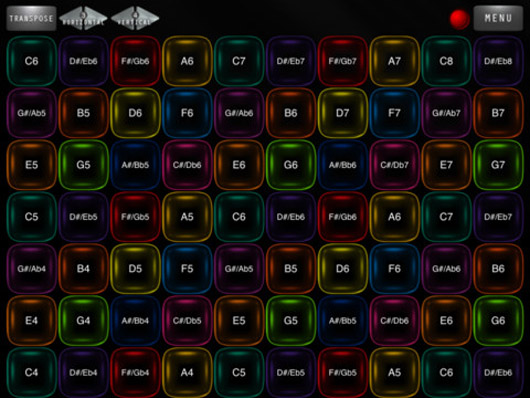Review: Polyplayground for iPad
MSRP: $5.99, Mike Gao Mobile Los Angeles beatsmith Mike Gao has designed an iPad app […]

MSRP: $5.99, Mike Gao Mobile
Los Angeles beatsmith Mike Gao has designed an iPad app aimed at allowing users to easily create complex chord structures and melodies using color-coded buttons and geometric patterns rather than a traditional piano keyboard. The result is a program that is part MIDI controller, part music-theory lesson, and part music-making mind fuck. In other words, not your average app.
Polyplayground’s interface seems simple enough at first glance. A grid is laid out with buttons clearly labelled according to the note and octave they represent, and each is color-coded in a fashion meant to highlight the sonic properties of the notes available. Red, orange, and yellow notes relate to each other more than their blue, green, and purple counterparts, allowing you to navigate the field of notes off the bat with a bit of (somewhat false) confidence. Certain patterns then yield a number of chord structures depending on how your grid of notes is set up (the app automatically starts off with perhaps its easiest grid, the 3×4 “Balzano Space”). These Tetris-like shapes take a minute to discover, but once you land on them, it becomes easy to anticipate the chord changes, which move from minor and major triads to seventh chords and even ninth chords (if you can manage to use five fingers). It’s truly impressive how easy it becomes to use these patterns once you’ve established them. The only problem becomes moving on to other grids—like a 3×5 or an 8×2 or, really, any combination you can think of—as every time the grid changes, so do the patterns that represent the chords you’re looking for. As you continue to explore these expanded grids, the concept behind the app becomes more and more murky, but this is where the color code becomes even more vital, as it gives the user the simple clues as to where to start building their patterns from.
Although there is an internal synthesizer included with the app, its real purpose is as a MIDI controller. After some tinkering with your iPad and the app’s settings, MIDI can be sent to and from Polyplayground using Virtual MIDI or an iPad accessory to convert the signals into readable MIDI notes for other hardware or software synths. This is perhaps Polyplayground’s greatest feature, as you can then record the MIDI notes it creates straight to your DAW or plug directly into a hardware synth and utilize its unique chord voicing capabilities with a much more powerful sound bank.
Truthfully, Mike Gao’s app seems like a production tool that most benefits users who come to it with a strong understanding of music theory, as approaching more than the default grid setup and its few related variations can prove to be quite a daunting task—considerably confusing and frustrating to those on the less-informed side of the musically trained spectrum. With that said, Polyplayground’s use of shapes and colors to represent chord structures and the relation of notes is still very intriguing, and could lead to some rewarding results if its user is willing to put in a good deal of time and exercise a modicum of patience. It appears to be the kind of app that is fun enough on the surface, but has a larger breadth of discoverable possibilities for those willing to dive in. Hopefully, a training video or written guide is on its way to help the beginners out.

